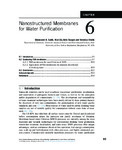Nanostructured Membranes for Water Purification
| dc.contributor.author | Omowunmi, A. Sadik | |
| dc.contributor.author | Du, Nian | |
| dc.contributor.author | Yazgan, Idris | |
| dc.contributor.author | Okello, Veronica | |
| dc.date.accessioned | 2019-05-06T08:05:30Z | |
| dc.date.available | 2019-05-06T08:05:30Z | |
| dc.date.issued | 2014 | |
| dc.identifier.uri | http://ir.mksu.ac.ke/handle/123456780/4359 | |
| dc.description.abstract | Nanoscale materials can be used to achieve wastewater purification, desalination, and inactivation of pathogenic bacteria and viruses, as well as for the adsorption and/or degradation of contaminants [1 16]. The development and sustainability of water treatment technologies have been mostly driven by three primary factors: the discovery of new rare contaminants, the promulgation of new water quality standards, and cost [17 23]. Most sources of water used for public drinking water supplies are not of suitable quality for consumption without some form of treatment | en_US |
| dc.language.iso | en_US | en_US |
| dc.subject | Nanostructured Membranes | en_US |
| dc.subject | Water Purification | en_US |
| dc.title | Nanostructured Membranes for Water Purification | en_US |
| dc.type | Article | en_US |
Files in this item
This item appears in the following Collection(s)
-
School of Pure and Applied Sciences [259]
Scholarly Articles by Faculty & Students in the School of Pure and Applied Sciences

